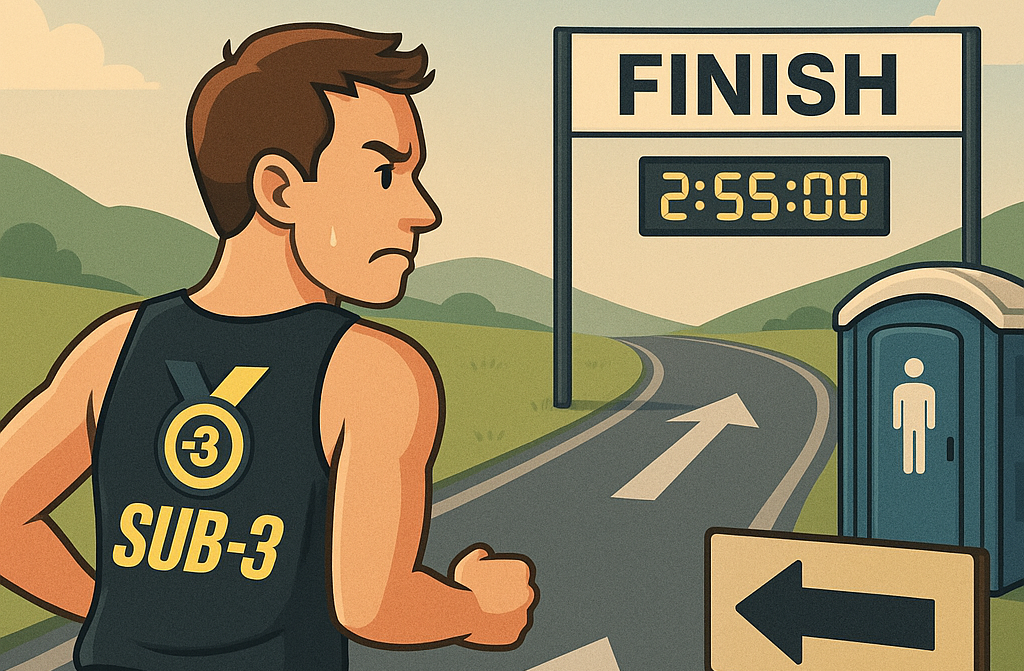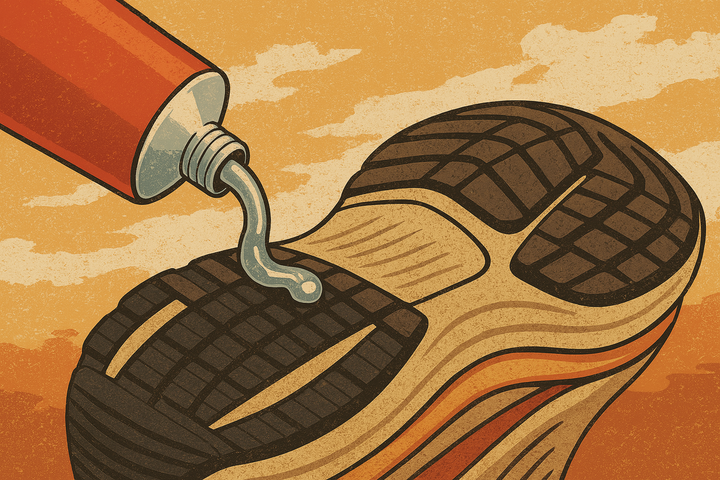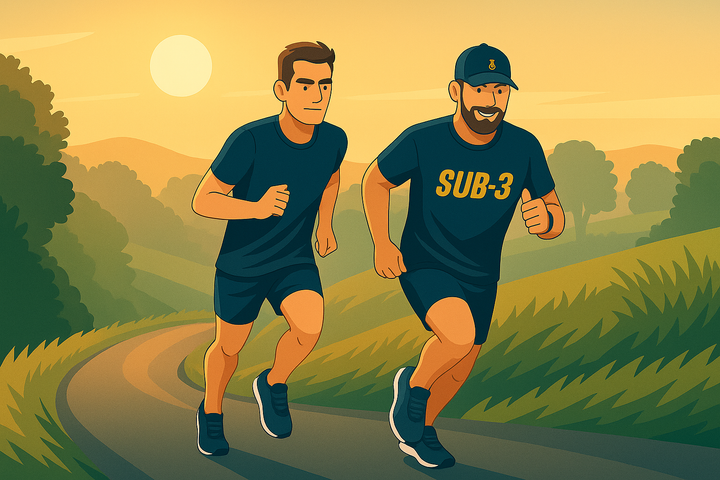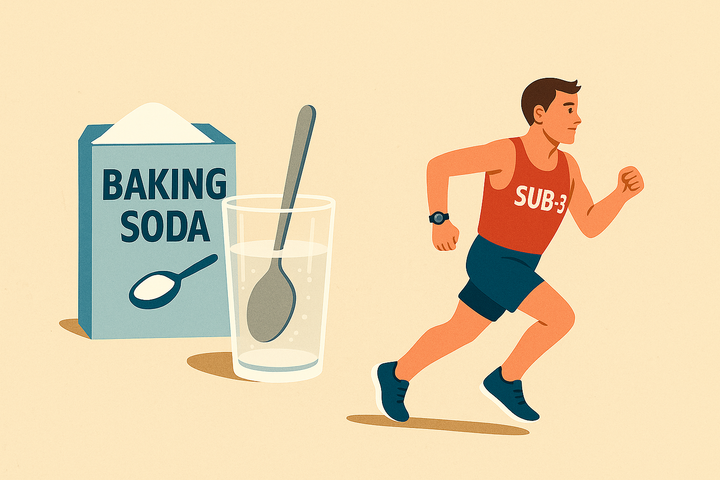What if I need to go to the toilet during a sub-3 marathon attempt?
It’s not the most glamorous aspect of marathon running, but it’s one nearly every runner has worried about at some point: what if I need the toilet mid-race?

It’s not the most glamorous aspect of marathon running, but it’s one nearly every runner has worried about at some point: what if I need the toilet mid-race?
When you’re chasing a sub-3 marathon, every second counts. But that doesn’t mean your bladder (or worse) will play ball. I’ve never had to stop during a sub-3 attempt, but I have been caught out in a previous marathon. Back in 2010, running the (now sadly defunct) Robin Hood Marathon, I was so distracted by a full bladder I couldn’t think straight. Eventually, I had to dash for the bushes, losing precious time and ultimately equalling - rather than beating - a PB I’d set five years earlier.
Since then, I’ve developed a routine. And if you race enough, your body does begin to learn. I typically go four or five times on race morning - first a couple of hours beforehand, then again around 15-20 minutes before the start. It’s become second nature. But it wasn't always this way. Alcohol, even just a couple of beers the night before, can completely throw things off. It messes with your fluid balance and your digestion. I now avoid it entirely, but if you’re drinking at all, give yourself a 48-hour buffer before race day.
Still, surprises happen. At Brighton in 2021, I was lining up for a final wee when we were unexpectedly called forward. I didn’t want to lose my spot in the elite pen, so I held it. The first 5-10km weren’t pleasant - my bladder ached, and I felt like I was on the back foot. But once the race settled in, I completely forgot about it. By the end, I didn’t even need to go. Perhaps the adrenaline helped. Perhaps I just sweated it out.
That’s the key thing: most of the time, these feelings pass. The body goes into race mode. But if it doesn’t, and you really need to go, just do it. Don’t overthink it. Paula Radcliffe’s 2005 London Marathon pit stop might be infamous, but it’s also proof that even world champions get caught short. If she can do it and still win, you can certainly do it and still break three.
Just don’t be precious. If you’re going to stop, act fast. Don’t queue for a portaloo unless it’s absolutely unavoidable. Find a tree or bush, get it done, and move on. I’ve even practised weeing while running during training. I wouldn’t necessarily recommend it - it’s messy, undignified, and only viable on empty trails. (And never wear white shoes!) But in a strange way, it gave me confidence: I knew that even in the worst case, I’d be able to cope. (Note - If you do practice coping strategies, only on secluded trails and within local laws; most runners certainly don’t need to!)
What about number twos? This is where prep is everything. In the 48 hours before a marathon, stick to simple, low-fibre foods. No curries, no spicy meals, no high-fat anything. I even switch from wholemeal to white bread. On race morning, eat at least two hours before the gun. And whatever else you pack, I highly recommend slipping two pieces of tissue paper into a tiny plastic seed bag. That’s saved me more than once in training and in races where the loos run out of paper. Slipping a glob of Vaseline in another seed bag can also help if the loo roll is a bit rough!
There’s also a psychological side to this. The more you worry, the more likely it is your gut will act up. The truth is, if you need to stop, it might actually help. A quick pause can drop your heart rate and steady your nerves - possibly leaving you in better shape for the final 10K. It’s not ideal, but it’s recoverable. This is a marathon, not a sprint.
Finally, a warning: some races, despite their best intentions, suffer from massive queues for the toilets. Arrive early. Go often. And avoid the horror of being five people from the front of the queue when the organisers start calling runners to the line.
If you're considering anti-diarrhoea medication, be cautious. I tried it once and wouldn’t again - it can leave you feeling bloated, uncomfortable, and struggling to go for days afterwards. These meds slow your whole digestive system, which can interfere with fuelling, hydration, and post-race recovery. Unless you’ve discussed it with a doctor and know how your body reacts, you're better off sticking to low-fibre meals, careful timing and a solid pre-race toilet routine.
In summary: Prepare well. Act fast. Avoid alcohol. If you’re experimenting with sodium bicarbonate loading, do not do so for the first time on race week, it often causes GI issues. And, if the worst happens, handle it calmly and carry on. Most people won't notice. And if they do, they'll have forgotten ten seconds later.
Five Ways to Minimise Toilet Trouble Mid-Marathon
1. Master your race morning routine.
Train your body to go early — ideally 4–5 times before the start. Don’t leave it to chance. Arrive with time to spare and make one final trip 15–20 minutes before the gun.
2. Ditch the alcohol (yes, even one beer).
Alcohol messes with fluid balance and digestion. If you’re drinking at all, stop 48 hours before race day. Sub-3 isn’t compatible with last orders.
3. Eat clean in the final 48 hours.
Low-fibre, low-fat, and no spice. Switch to white bread. Skip the curry. You’re fuelling performance, not planning flavour. Think simple and safe.
4. Pack the essentials.
Two pieces of tissue in a small seed bag can save your race. A dab of Vaseline in another bag? Even better. Portable confidence in your shorts pocket.
5. Don’t panic - act fast.
If you need to stop, do it quickly. No queuing unless essential. Bush, tree, move on. A short break might even steady your nerves and help your final 10K.
Enjoyed this article? Help keep Sub-3 running — support us with a coffee.
To help fund the running of the site, Sub-3 is an Amazon Associate and earns from qualifying purchases. We only recommend gear or kit that has genuinely helped in our own running and that we believe is worth considering.



